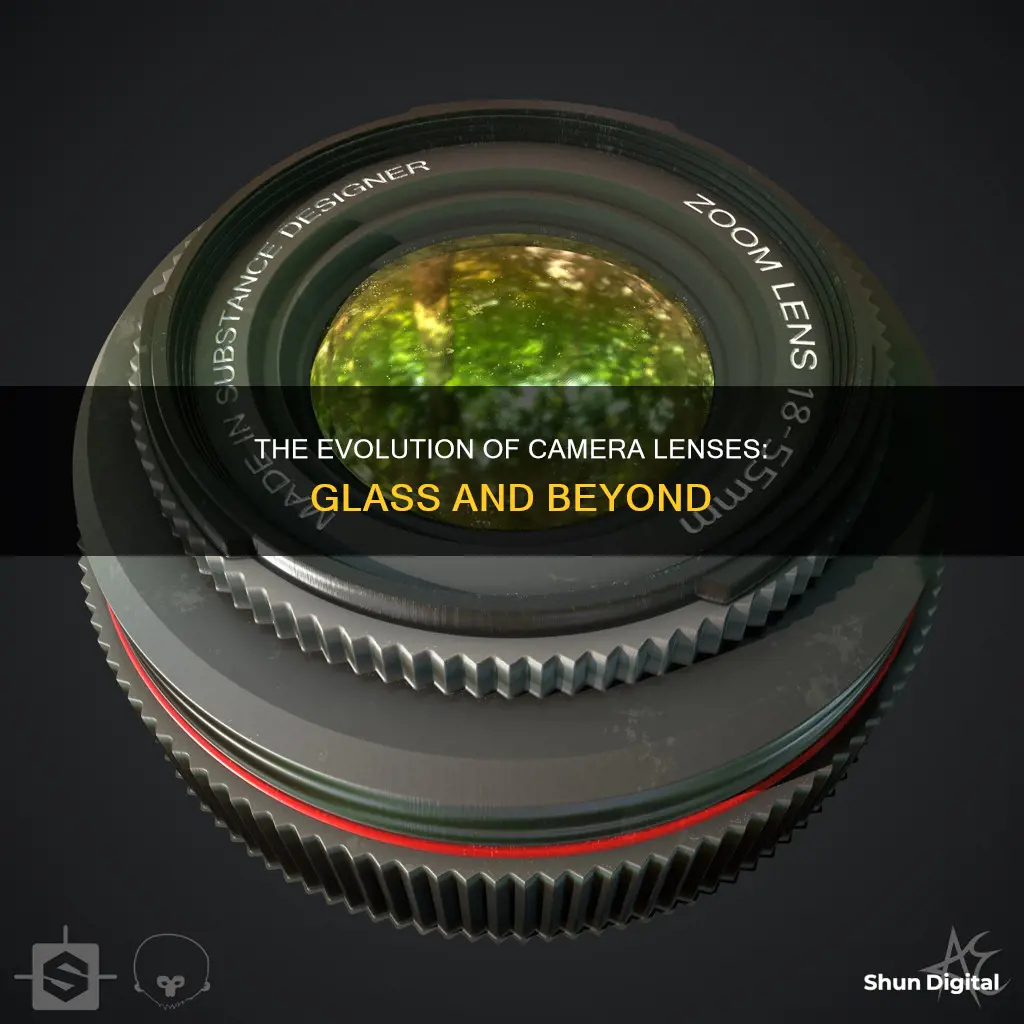
Camera lenses are intricate devices that play a crucial role in capturing images. They are composed of multiple elements, including glass, metal, and plastic, all working together to focus light onto a camera sensor or film. The glass lens elements are carefully crafted to bend and direct light, while the metal or plastic lens barrel provides structural support. In addition, modern lenses incorporate autofocus motors and electronics, allowing for precise and quick focus adjustments. The interplay between these components and materials is what enables photographers to capture the world with clarity and visual impact.
| Characteristics | Values |
|---|---|
| Core Material | Glass |
| Glass Type | Optical Glass, Low-Dispersion Glass, Aspherical Glass, Fluoride Optical Crystal |
| Lens Elements | Multiple |
| Lens Groups | One or more |
| Lens Coatings | Anti-reflective coatings, Multi-coating technology |
| Lens Barrel Material | Metal, High-quality Plastic |
| Aperture Mechanism | Overlapping metal blades |
| Weather Sealing | Seals and Gaskets |
What You'll Learn

Glass is the primary material used for camera lenses
Different types of glass, such as low-dispersion and aspherical glass, are often combined in complex arrangements to correct for various optical aberrations and enhance image quality. The shape of the glass is also important, with most consumer-grade lenses being spherical in design, while professional lenses usually utilise an aspheric shape, making them curved instead of fully rounded. Different waves of light react differently with certain glass shapes, so careful design is important to optimise image quality.
While glass is the primary material used for camera lenses, other materials are also used. These include quartz glass, fluorite, plastics like acrylic (Plexiglass), and even germanium and meteoritic glass. The use of these alternative materials allows for the manufacturing of strongly aspherical lens elements, which are difficult or impossible to manufacture in glass. They also simplify or improve lens manufacturing and performance. However, plastics are not typically used for the outermost elements of lenses as they scratch easily.
Polaroid Cameras: Still in Production, Still in Demand
You may want to see also

Metal and plastic provide structural support
Metal and plastic are crucial components of camera lenses, providing the much-needed structural support to protect the delicate glass elements. The lens barrel, the structural component that houses the glass elements, is typically crafted from either metal or high-quality plastic. These materials offer differing advantages while ensuring the durability and integrity of the lens as a whole.
Metal lens barrels are commonly found in professional-grade lenses, prized for their robustness and longevity. Metal, with its inherent strength, safeguards the lens components from damage and ensures a long-lasting performance. This makes metal lens barrels the go-to choice for professional photographers who require gear that can withstand the rigours of frequent use and challenging environments.
On the other hand, high-quality plastics offer an alternative that is equally structurally sound but with the added benefit of being lighter in weight. Plastic lens barrels strike a balance between durability and portability, making them a popular choice for photographers seeking budget-friendly options without compromising image quality. The use of plastic in lens construction also enables the manufacturing of strongly aspherical lens elements, which are difficult or impossible to create with glass. This innovation not only simplifies lens manufacturing but also enhances lens performance.
The choice between metal and plastic lens barrels caters to diverse photographic needs, ensuring that photographers can find the right tool for their specific requirements. Metal barrels excel in durability and longevity, while plastic barrels offer a lightweight and cost-effective alternative without sacrificing image quality.
In addition to their structural roles, metal and plastic components also contribute to the intricate workings of modern lenses. For instance, autofocus lenses incorporate complex motors and electronic components that work in tandem with the optical glass to deliver precise and swift autofocus capabilities. The integration of metal and plastic parts in these systems ensures the smooth operation of autofocus mechanisms, further showcasing the importance of these materials in contemporary lens design.
The use of metal and plastic in camera lenses extends beyond mere structural support, as these materials also enable the incorporation of advanced features that enhance the overall photographic experience. This includes weather sealing, where strategic placement of seals and gaskets made from materials like rubber helps protect lenses from dust, moisture, and other environmental factors. Such innovations further highlight the versatility and importance of metal and plastic in lens construction, contributing to the overall functionality and resilience of modern camera lenses.
Recharging Olympus Camera Batteries: A Step-by-Step Guide
You may want to see also

Lens coatings enhance performance
Camera lenses are made of glass, quartz glass, fluorite, plastics like acrylic, germanium, meteoritic glass, and other materials. The front element of a lens is critical to the performance of the whole assembly. Modern lenses are almost always coated to enhance performance and reduce abrasion, flare, and surface reflectance, and to adjust color balance.
Lens coatings are applied to enhance the durability, performance, and appearance of the lenses. Coatings can be used to alter the optical properties of system components by increasing or decreasing reflectance, transmittance, absorptance, or polarization. A coating can be a single layer of aluminum applied to glass to produce a flat mirror, or it can consist of multiple layers of oxides, metals, or dielectric thin films that in combination achieve the reflectance or transmittance of a desired wavelength by a process of controlled interference.
An optical coating is expected to have the dual properties of producing the desired optical effects while improving the hardness and durability of an element, as in plastics or eyeglasses. Coatings are vital components of optical systems and are essential for spectroscopy, medical diagnosis, environmental analysis, quality control, and more recently, ultrafast laser applications.
Anti-reflective (AR) coating is a microscopically thin multi-layer coating that eliminates reflections from the front and back surfaces of eyeglass lenses. By doing so, AR coating makes lenses nearly invisible, so people can focus on the wearer's eyes instead of distracting reflections. AR coating also eliminates glare caused by light reflecting off the lenses, providing better vision for night driving and more comfortable vision for reading and computer use.
Scratch-resistant coating is another common type of lens coating. While no eyeglass lenses are 100% scratch-proof, lenses treated with a clear, scratch-resistant coating have a much harder surface that is more resistant to scratching.
Ultraviolet (UV) treatment is another beneficial lens treatment. An invisible dye blocks ultraviolet (UV) light, protecting the wearer's eyes from potential damage caused by overexposure to UV light. Regular plastic eyeglass lenses block most UV light, but adding a UV-blocking dye boosts UV protection to 100% for added safety.
Are Batteries Included? Camera Shopping Basics
You may want to see also

Autofocus motors and electronics enable precise focus
Modern autofocus lenses feature complex motors, such as Sigma's Hyper Sonic Motor (HSM) autofocus system. They also have gears and cams to precisely control autofocus groups and zoom rings. Enabling these components to coordinate with a wide array of cameras also requires a lot of electrical components.
An autofocus (AF) optical system uses a sensor, a control system, and a motor to focus on an automatically or manually selected point or area. The data collected from AF sensors is used to control an electromechanical system that adjusts the focus of the optical system.
The speed of the AF system is highly dependent on the widest aperture offered by the lens at the current focal length. F-stops of around f/2 to f/2.8 are generally considered best for focusing speed and accuracy.
Most multi-sensor AF cameras allow manual selection of the active sensor, and many offer automatic selection using algorithms that attempt to discern the location of the subject. Some AF cameras can detect whether the subject is moving towards or away from the camera, including speed and acceleration, and keep focus—a function used mainly in sports and other action photography.
Different types of motors are used to autofocus lenses. The oldest type is a small electric motor, which is cheap but loud and slow. This type of motor is only used in the cheapest lenses.
A more advanced type of motor is based on piezoelectric materials that change their shape when they receive an electric current. This type of motor is very fast and quiet, and it allows for hand-focusing at any time by twisting the focus ring. This is called Full Time Manual (FTM).
Some camera bodies do not include an autofocus motor and therefore cannot autofocus with lenses that lack an inbuilt motor.
The Ultimate Battery Backup Plan for Photographers
You may want to see also

Aperture mechanisms control light intake
The size of the aperture is measured by the f-stop, which is the ratio of the lens's focal length to the effective aperture diameter (the entrance pupil). A lower f-number denotes a larger aperture, allowing more light to reach the film or image sensor. Conversely, a higher f-number indicates a smaller aperture and reduced light intake. For example, an aperture of f/2 allows for exposure times one-quarter that of f/8.
The aperture not only controls the amount of light entering the camera but also influences the depth of field. A wider aperture creates a shallow depth of field, resulting in a blurry or fuzzy background. On the other hand, a smaller aperture produces a wider depth of field, leading to a sharper and clearer image.
The aperture can be adjusted manually or through semi-automatic modes like aperture priority (Av or A mode). In aperture priority mode, the photographer selects the aperture setting, and the camera automatically determines the shutter speed based on the internal light meter.
Aperture mechanisms are an essential aspect of camera lenses, as they regulate light intake and influence the depth of field, ultimately contributing to the overall exposure and artistic effect of the photograph.
Night Mode Camera: ZTE Axon 7 Mini's Secret Feature
You may want to see also
Frequently asked questions
Camera lenses are primarily made of optical glass, which is designed for clarity and minimal distortion.
While glass is the main component, other materials such as metal, high-quality plastic, and composite materials are also used for structural support and to house the glass elements.
Glass lenses are responsible for bending and focusing light onto the camera sensor, and different types of glass can be combined to correct optical aberrations and enhance image quality.
Creating a camera lens involves a complex process that includes mixing and melting glass powder, shaping it into strips, cutting and polishing individual lens elements, applying coatings, and assembling all the components into a finished product.







